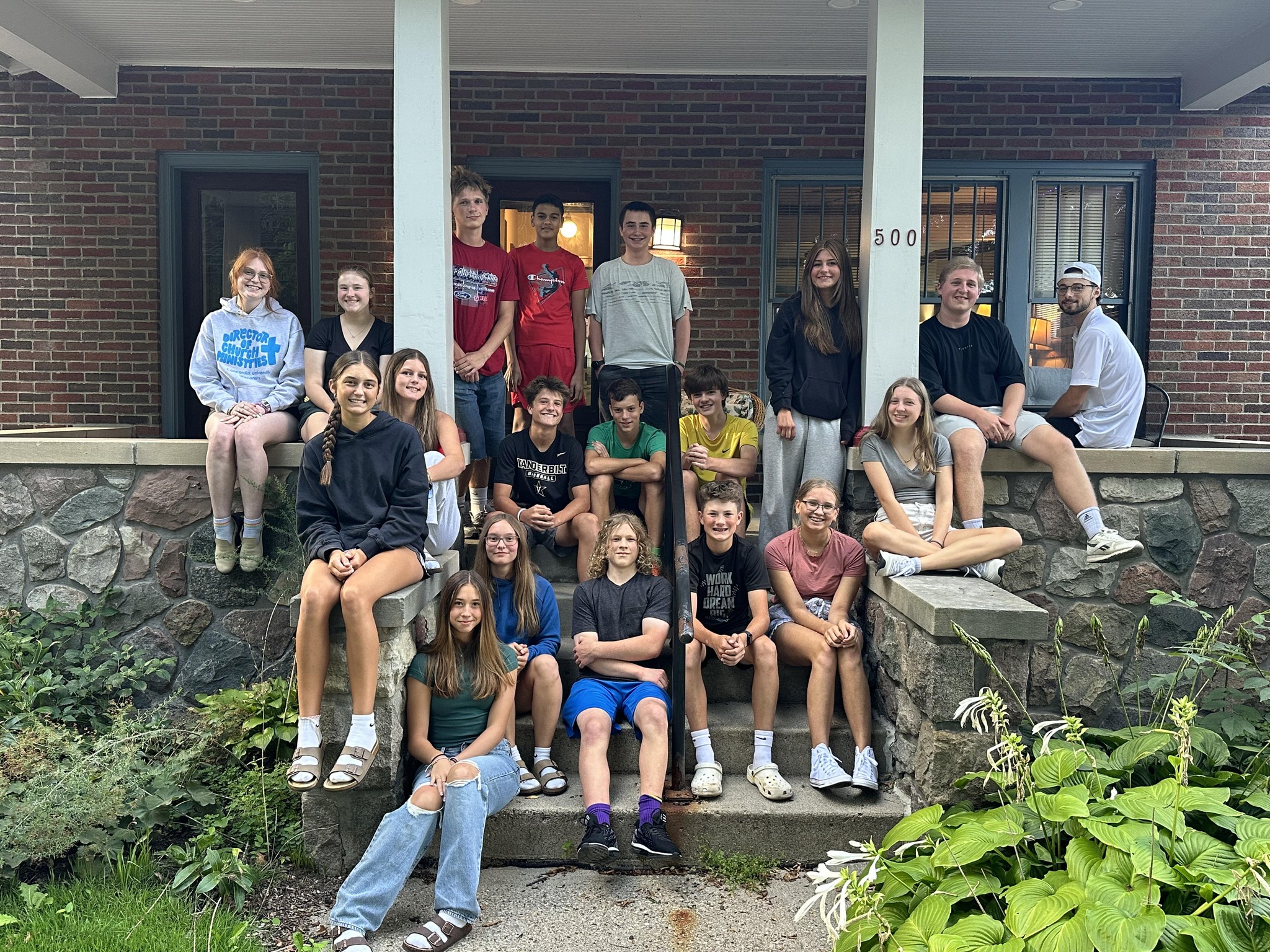Ländler
- Home Page 15

Cornish Pasties
Dining Services Recipe | MTU Alumni Recipe
Perfect weather for a Husky. 💛🐾#MichiganTech pic.twitter.com/iGuBVE484J
— Michigan Tech (@michigantech) January 24, 2024
2024 Financial Report: Net Position $479,190,705
Notre Dame in Ireland: Chef David’s Scones
“…I have spread my dreams under your feet;
Tread softly because you tread on my dreams.”
–W.B. Yeats | ‘He Wishes for the Cloths of Heaven’
The history of scones is believed to have originated in Scotland. The name “scone” is said to come from the Dutch word “schoonbrot,” which means “beautiful bread.” Scones have a long and interesting history that dates back several centuries.
Originally, scones were not the sweet, buttery treats we know today. Instead, they were simple unleavened oatcakes or griddle cakes made from barley, oats, or wheat. These early scones were baked on griddles or stovetops rather than being oven-baked.
As time went on, the recipe for scones evolved, and they became more commonly associated with Scotland and England. The Scottish version of scones was typically round and made with oats. They were cooked on a griddle or in a pan and then cut into triangular sections, which were known as “bannocks.” These bannocks were the ancestors of the modern scone.
In the 19th century, with the advent of baking powder and modern ovens, scones began to be baked instead of griddle-cooked. The addition of baking powder allowed scones to rise and become lighter and fluffier. The ingredients were refined to include flour, butter, milk or cream, and a leavening agent like baking powder. This marked the shift from the traditional oat-based scone to the more recognizable wheat-based scone we know today.
Scones’ popularity spread beyond Scotland and England, and they became a common teatime treat across the United Kingdom and other English-speaking countries. The addition of raisins, currants, or other dried fruits, as well as sugar, transformed scones into the sweet delicacies that are commonly enjoyed today, often served with clotted cream and jam in the classic English afternoon tea.
In the United States, scones have also become popular, with various regional and cultural variations. American scones may be larger, sweeter, and have a wider variety of flavor options, such as blueberry, cranberry-orange, or chocolate chip. Today, scones continue to be beloved treats enjoyed for breakfast, brunch, afternoon tea, or as a delightful snack with a cup of tea or coffee. Their history reflects centuries of evolution and cultural influence, making them a delightful and enduring part of baking traditions worldwide.
National Standards Authority of Ireland
Standard Scone Recipe
The standard scone is a simple and versatile preparation that can be customized with various additions, such as dried fruits, nuts, or chocolate chips, to suit different tastes.
Here is a basic recipe for making standard scones:
Ingredients:
- 2 cups all-purpose flour
- 1/4 cup granulated sugar
- 1 tablespoon baking powder
- 1/2 teaspoon salt
- 1/2 cup cold unsalted butter, cut into small cubes
- 1/2 cup milk (plus more for brushing on top)
- 1 large egg
- Optional: 1 teaspoon vanilla extract or other flavorings (e.g., almond extract, lemon zest)
- Optional: Additions such as dried fruits, chocolate chips, or nuts (about 1/2 cup)
Instructions:
- Preheat your oven to 400°F (200°C) and line a baking sheet with parchment paper.
- In a large mixing bowl, whisk together the flour, sugar, baking powder, and salt until well combined.
- Add the cold butter cubes to the flour mixture and use a pastry cutter or your fingers to work the butter into the flour until the mixture resembles coarse crumbs. The butter should be well distributed but still in small pieces.
- If you’re adding any optional flavorings or additions, mix them into the dry ingredients at this stage.
- In a separate small bowl, whisk together the milk, egg, and optional vanilla extract (or other flavorings) until well combined.
- Create a well in the center of the dry ingredients and pour the wet mixture into it. Gently stir the ingredients together until just combined. Be careful not to overmix; the dough should be slightly crumbly but hold together.
- Transfer the dough onto a lightly floured surface and shape it into a round disk, about 1 inch (2.5 cm) thick.
- Use a sharp knife or a biscuit cutter to cut the dough into wedges or rounds, depending on your preference. Traditionally, scones are cut into triangular shapes.
- Place the scones on the prepared baking sheet, leaving some space between them.
- Brush the tops of the scones with a little milk to give them a nice golden color when baked.
- Bake the scones in the preheated oven for about 15-20 minutes or until they are lightly golden on top.
- Remove from the oven and let them cool slightly before serving. Scones are best enjoyed fresh and can be served with butter, clotted cream, jam, or any other toppings of your choice.
This standard scone recipe provides a classic and delicious base that you can experiment with by adding various flavors and mix-ins to create your own unique variations.
Leās on ānum, leās on eallum
This content is accessible to paid subscribers. To view it please enter your password below or send mike@standardsmichigan.com a request for subscription details.
Bagel & Lox
Culture and Cuisine Recipe of the Week
Hamburg’s Master Plan for Education for Sustainable Development 2030
“With this weekly post we want to introduce you into the culinary range of the English speaking world. Each week we present you an iconic dish and give you information around its origin, preparation and eating habits. This week we are visiting the Big Apple – New York. Bagels can be regarded as a true American melting-pot meal.” — von Nadja Wostiera (Language graduate and blog author)
Standards Michigan: Food/Kitchen/Farm/Agriculture
Smart Campuses Stupid Cities
This content is accessible to paid subscribers. To view it please enter your password below or send mike@standardsmichigan.com a request for subscription details.
Coffee Society
Annual report and financial statements 31 July 2024 | “Campus” Masterplan
Durham (Dunholm O.E.) as a Northumbrian learning settlement originates with its Cathedral; founded in 995 AD as part of a Benedictine monastery. Monks maintained libraries and created an intellectual hub for the English speaking peoples. Fast forward a millennium and we find “DU Coffee Society” which describes itself as a welcoming space for students to learn about coffee making, latte art and each other.
🗣️Did you miss out on Assembly last week? Don’t worry, our Media Observer, Nicole Ireland, was there to catch all the action!
Check out her report on our website here: https://t.co/lKSFHjhyyu pic.twitter.com/t70D0mKmcn
— Durham SU (@durhamSU) November 29, 2023
FYI:
LSE: “The Benefits and Costs of International Higher Education Students to the UK Economy
PwC: UK Higher Education Financial Sustainability Report
Don’t say ‘right-wing’, say ‘pattern recognizer’ https://t.co/0s5FNnlCOB pic.twitter.com/s0YuVy4jw6
— 𝒩𝒶𝓉𝒶𝓁𝒾𝒶 (@classicspilled) November 3, 2025
Autumn Syllabus Week 45 | November 3 – November 9
Jordan Peterson and Douglas Murray – The Importance of Gratitude
Monday | November 3 | Colloquium 16:00 UTC
Tuesday | November 4 | Colloquium 16:00 UTC
Wednesday | November 5 | Colloquium 16:00 UTC
Thursday | November 6| Colloquium 15:00 UTC
Welcome to math class!
Year 16, woot woot! pic.twitter.com/5IIuQ3Tomc— Ashley (@PlanterAsh) November 6, 2025
Friday | November 7 | Colloquium 15:00 UTC
Saturday | November 8
Sunday | November 9
The Common Cup
Michigan Central Summer Fall | Michigan Central Winter Spring
Open every day since 2007: offering locally sourced coffee, teas, baked goods, and a welcoming space for studying or events. Across Linden Street from First Presbyterian Church of Ann Arbor, Angell Elementary School and footsteps away from Chi Omega and seven other sororities and fraternity houses on the oddly-shaped lot bounded by South University. Washtenaw and Hill Streets.
A post shared by The Common Cup (@thecommoncupcoffee)
The University Lutheran Chapel in Ann Arbor, Michigan was designed by architect Glen Paulsen in 1959; a local Ann Arbor architect known for his modernist work and close ties to the University of Michigan community. The chapel is one of his most celebrated designs and is widely regarded as an outstanding example of mid-20th-century ecclesiastical architecture in the Midwest. The dramatic hyperbolic-paraboloid roof and the integration of natural light through colored glass strips are signature elements of the building.His work often emphasized clean lines, structural expression (e.g., exposed concrete and steel), and integration with natural surroundings, influenced by his time with Eero Saarinen and his teaching roles at the University of Michigan and Cranbrook Academy of Art. While the University Lutheran Chapel (1959) in Ann Arbor exemplifies his ecclesiastical modernism with its hyperbolic-paraboloid roof, below is a curated list of his other key projects, drawn from biographical records, architectural archives, and historical surveys. In the fullness of time his private practice from 1958 to 1969 morphed into TMP (Tarapata-MacMahon-Paulsen, 1969–1977).
New update alert! The 2022 update to the Trademark Assignment Dataset is now available online. Find 1.29 million trademark assignments, involving 2.28 million unique trademark properties issued by the USPTO between March 1952 and January 2023: https://t.co/njrDAbSpwB pic.twitter.com/GkAXrHoQ9T
— USPTO (@uspto) July 13, 2023
Standards Michigan Group, LLC
2723 South State Street | Suite 150
Ann Arbor, MI 48104 USA
888-746-3670























